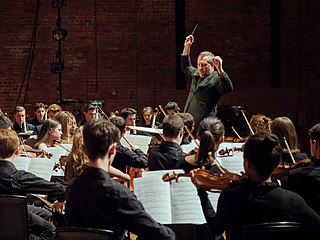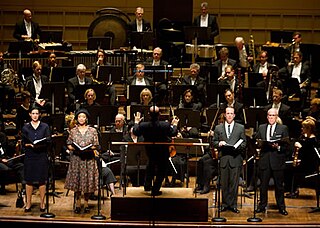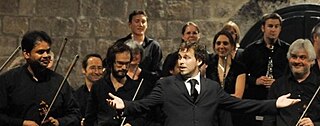Related Research Articles
EXPO is an orchestral composition by the Finnish composer Magnus Lindberg. It was the first work commissioned by the New York Philharmonic under the conductor Alan Gilbert, and was Lindberg's first commission as the orchestra's composer-in-residence. The piece was first performed on September 16, 2009 at Avery Fisher Hall, New York City, during Alan Gilbert's inaugural concert with the New York Philharmonic. EXPO was the first newly commissioned work to open the New York Philharmonic's concert season since the premiere of Aaron Copland's Connotations under Leonard Bernstein on September 23, 1962.

Esa-Pekka Salonen is a Finnish conductor and composer. He is the music director of the San Francisco Symphony and conductor laureate of the Los Angeles Philharmonic, Philharmonia Orchestra in London and the Swedish Radio Symphony Orchestra. In 2024, he announced his resignation from the San Francisco Symphony upon the expiration of his contract in 2025.

Thomas Joseph Edmund Adès is a British composer, pianist and conductor. Five compositions by Adès received votes in the 2017 Classic Voice poll of the greatest works of art music since 2000: The Tempest (2004), Violin Concerto (2005), Tevot (2007), In Seven Days (2008), and Polaris (2010).

Steven Edward Stucky was a Pulitzer Prize-winning American composer.
Christopher Chapman Rouse III was an American composer. Though he wrote for various ensembles, Rouse is primarily known for his orchestral compositions, including a Requiem, a dozen concertos, and six symphonies. His work received numerous accolades, including the Kennedy Center Friedheim Award, the Grammy Award for Best Classical Contemporary Composition, and the Pulitzer Prize for Music. He also served as the composer-in-residence for the New York Philharmonic from 2012 to 2015.

Ryan Bell McAdams is an American conductor.

Anna Sigríður Þorvaldsdóttir is an Icelandic composer. She has been called "one of Iceland's most celebrated composers", and was the 2012 winner of the Nordic Council Music Prize. Her music is frequently performed in Europe and in the United States, and is often influenced by landscapes and nature.
The Second Concerto for Orchestra is a concerto for orchestra by the American composer Steven Stucky. The work was commissioned by the Los Angeles Philharmonic while Stucky was their composer-in-residence for the inaugural season of the Walt Disney Concert Hall. It was completed in 2003 and was first performed on March 12, 2004, with the conductor Esa-Pekka Salonen leading the Los Angeles Philharmonic. The piece was awarded the 2005 Pulitzer Prize for Music.
Rhapsodies for Orchestra is a single-movement orchestral composition by the American composer Steven Stucky. The work was jointly commissioned by the New York Philharmonic and the BBC for the Philharmonic's European tour in August and September 2008. The piece had its world premiere August 28, 2008 in Royal Albert Hall at The Proms, with the New York Philharmonic performing under conductor Lorin Maazel.
Son et lumière is a symphonic poem by the American composer Steven Stucky. It was commissioned by the Baltimore Symphony Orchestra and composed between June and December 1988. The work was premiered in Baltimore by the Baltimore Symphony Orchestra under conductor David Zinman, May 18, 1989.
The Classical Style: An Opera is an American comic opera in seven scenes, with music by Steven Stucky and libretto by Jeremy Denk. The opera was a joint commission from the Aspen Music Festival, Carnegie Hall, the Ojai Music Festival, and Ojai North!, and was premiered under the conductor Robert Spano on June 13, 2014 at the Ojai Music Festival in Ojai, California. The opera is inspired by the musicologist and pianist Charles Rosen's 1971 book The Classical Style and thus follows composers Wolfgang Amadeus Mozart, Joseph Haydn, and Ludwig van Beethoven as they descend from heaven into a modern-day classical music climate. The Classical Style was Stucky's last large-scale composition before his death in 2016.
Pinturas de Tamayo is an orchestral composition in five movements by the American composer Steven Stucky. The work was commissioned by the Chicago Symphony Orchestra, who premiered the work on March 28, 1996, under the conductor Michael Gielen in Symphony Center, Chicago. The piece is inspired by the paintings of the Mexican artist Rufino Tamayo.
The Piano Concerto is a concerto for solo piano and orchestra in three movements by the Finnish composer Esa-Pekka Salonen. The work was jointly commissioned by the New York Philharmonic, the BBC, the NDR Symphony Orchestra, and Radio France. It was premiered February 1, 2007 in Avery Fisher Hall, New York City, with Salonen conducting the pianist Yefim Bronfman and the New York Philharmonic. Salonen dedicated the piece to Yefim Bronfman.
One Sweet Morning is a four-movement song cycle for mezzo-soprano solo and orchestra by the American composer John Corigliano. The work was jointly commissioned by the New York Philharmonic and the Shanghai Symphony Orchestra to commemorate the 10th anniversary of the September 11 attacks. It was given its world premiere on September 30, 2011, by the mezzo-soprano Stephanie Blythe and the New York Philharmonic under the conductor Alan Gilbert. The piece is dedicated to the memory of Natalie and Serge Koussevitzky.
The Concerto for Two Flutes and Orchestra is a composition for two flutes and orchestra by the American composer Steven Stucky. The work was commissioned by the Los Angeles Philharmonic, for which Stucky was formerly composer-in-residence and then New Music Adviser. The piece was composed from October through December 1994 and was given its world premiere in Los Angeles by the Los Angeles Philharmonic under the conductor Esa-Pekka Salonen on February 23, 1995.
Scheherazade.2 is a dramatic symphony for solo violin and orchestra by the American composer John Adams. The work was jointly commissioned by the New York Philharmonic, the Concertgebouw & the Royal Concertgebouw Orchestra, and the Sydney Symphony Orchestra. It was written specifically for the violinist Leila Josefowicz, who performed its world premiere with the New York Philharmonic under Alan Gilbert at Avery Fisher Hall on March 26, 2015.
The Piano Concerto No. 2 is a composition for solo piano and orchestra by the Finnish composer Magnus Lindberg. The work was jointly commissioned by the Royal Concertgebouw Orchestra, the Gothenburg Symphony Orchestra, and the New York Philharmonic, for which Lindberg was then composer-in-residence. It was given its world premiere at Avery Fisher Hall on May 3, 2012 by the pianist Yefim Bronfman and the New York Philharmonic under the direction of Alan Gilbert.
Polaris: Voyage for Orchestra is an orchestral composition by the British composer Thomas Adès. The work was co-commissioned by the New World Symphony under the direction of Michael Tilson Thomas for the opening of the New World Center. The New World Symphony was joined in commission by the Royal Concertgebouw Orchestra, the New York Philharmonic, the Calouste Gulbenkian Foundation, the Barbican Centre, the Los Angeles Philharmonic, and the San Francisco Symphony. It was given its world premiere by Michael Tilson Thomas and the New World Symphony at the New World Center in Miami Beach on January 26, 2011.
Dreamwaltzes is an orchestral composition by the American composer Steven Stucky. The work was commissioned by the Minnesota Orchestra for their annual Sommerfest series with support from the Jerome Foundation. The piece was completed in April 1986 and its world premiere was given by the Minnesota Orchestra under the direction of Leonard Slatkin on July 17, 1986. It is dedicated to the violinist Sonya Monosoff and Carl Pancaldo. The piece brought Stucky to prominence in the contemporary classical community and remains one of his most popular compositions.
Unsuk Chin's Clarinet Concerto was written in 2014 on a joint commission from the Gothenburg Symphony Orchestra, WDR Symphony Orchestra Cologne, Philharmonia Orchestra, Barcelona Symphony Orchestra, and the New York Philharmonic. A partial premiere of piece was given by the clarinetist Kari Kriikku and the Gothenburg Symphony Orchestra conducted by Kent Nagano at the Gothenburg Concert Hall on May 8, 2014; the complete concerto was given its world premiere by Kriikku and the New York Philharmonic conducted by Alan Gilbert at Avery Fisher Hall on September 23, 2014.
References
- ↑ "'Symphony' by Steven Stucky". Los Angeles Times . September 26, 2012. Retrieved April 4, 2015.
- 1 2 Ng, David (September 26, 2012). "Steven Stucky marks return to L.A. with his very own 'Symphony'". Los Angeles Times . Retrieved April 4, 2015.
- 1 2 Tommasini, Anthony (November 30, 2012). "A New Work Bares Its Secrets, With Feeling". The New York Times . Retrieved April 4, 2015.
- ↑ Oksenhorn, Stewart (July 21, 2013). "Music Festival: A new start for new music in Aspen". The Aspen Times . Retrieved April 4, 2015.
- ↑ "Alan Gilbert and the New York Philharmonic: New York Philharmonic 2012–13 Season" (PDF). New York Philharmonic . 2013. Retrieved April 3, 2015.